NUR250: Assessment 1 - Mrs. Rose's Nursing Care Plan, SS 2019
VerifiedAdded on 2022/09/08
|13
|3434
|30
Report
AI Summary
This assignment presents a nursing care plan for Mrs. Rose, a patient potentially suffering from Chronic Obstructive Pulmonary Disease (COPD). The plan addresses acute pain related to chest pain, risk of ineffective tissue perfusion due to breathing problems, and anxiety related to shortness of breath. It includes goals of care, detailed nursing interventions with rationales, and evaluation strategies for each nursing problem. The assignment also covers patient education, emphasizing medical adherence and self-management techniques. It further details Mrs. Rose's medication regimen, including the use of Salbutamol and Oral Paracetamol, explaining their purposes, administration, and potential side effects. The plan integrates Mrs. Rose's clinical history, including hyperlipidaemia, obesity, and smoking habits, to formulate comprehensive and patient-centered care strategies.
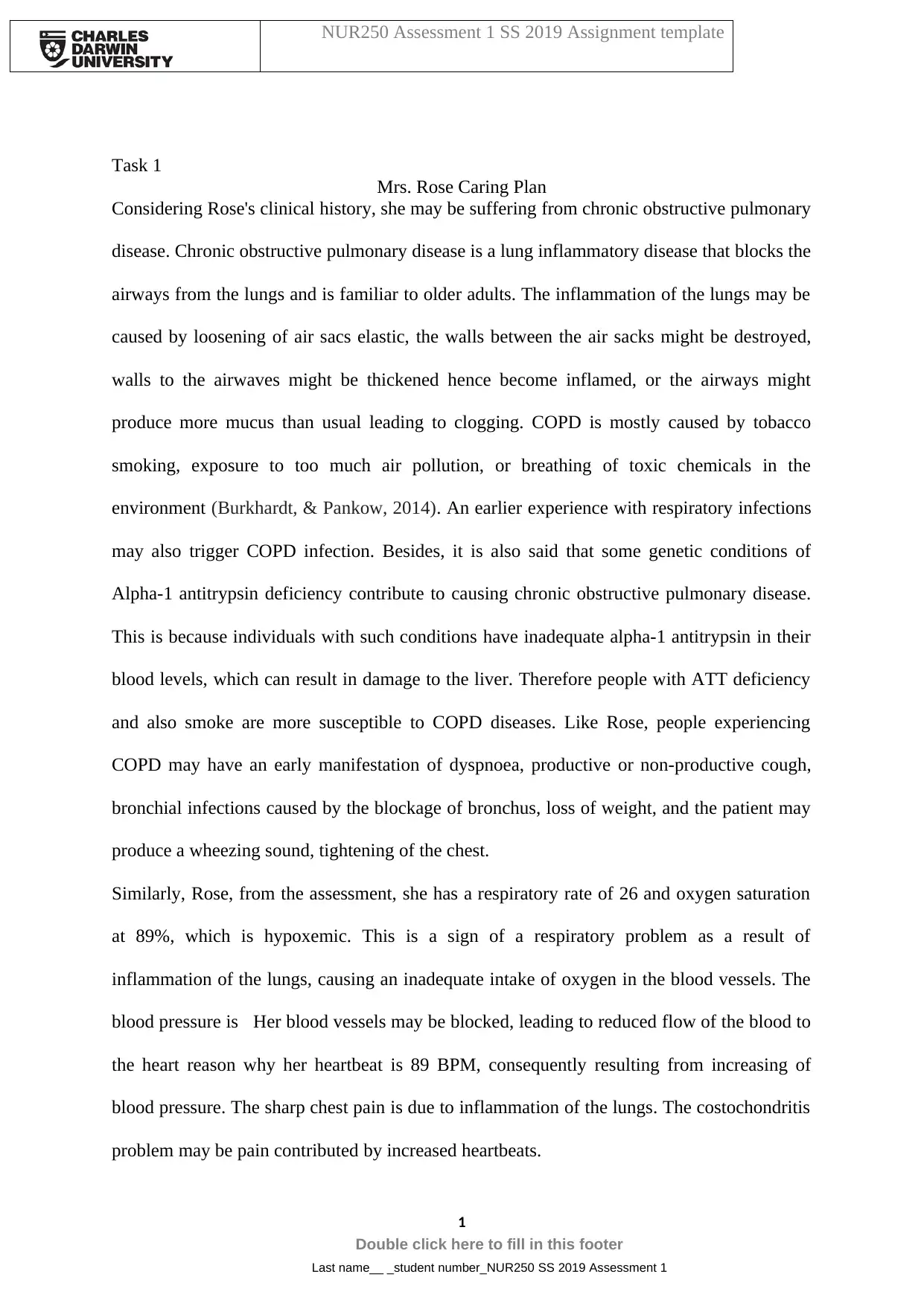
Task 1
Mrs. Rose Caring Plan
Considering Rose's clinical history, she may be suffering from chronic obstructive pulmonary
disease. Chronic obstructive pulmonary disease is a lung inflammatory disease that blocks the
airways from the lungs and is familiar to older adults. The inflammation of the lungs may be
caused by loosening of air sacs elastic, the walls between the air sacks might be destroyed,
walls to the airwaves might be thickened hence become inflamed, or the airways might
produce more mucus than usual leading to clogging. COPD is mostly caused by tobacco
smoking, exposure to too much air pollution, or breathing of toxic chemicals in the
environment (Burkhardt, & Pankow, 2014). An earlier experience with respiratory infections
may also trigger COPD infection. Besides, it is also said that some genetic conditions of
Alpha-1 antitrypsin deficiency contribute to causing chronic obstructive pulmonary disease.
This is because individuals with such conditions have inadequate alpha-1 antitrypsin in their
blood levels, which can result in damage to the liver. Therefore people with ATT deficiency
and also smoke are more susceptible to COPD diseases. Like Rose, people experiencing
COPD may have an early manifestation of dyspnoea, productive or non-productive cough,
bronchial infections caused by the blockage of bronchus, loss of weight, and the patient may
produce a wheezing sound, tightening of the chest.
Similarly, Rose, from the assessment, she has a respiratory rate of 26 and oxygen saturation
at 89%, which is hypoxemic. This is a sign of a respiratory problem as a result of
inflammation of the lungs, causing an inadequate intake of oxygen in the blood vessels. The
blood pressure is Her blood vessels may be blocked, leading to reduced flow of the blood to
the heart reason why her heartbeat is 89 BPM, consequently resulting from increasing of
blood pressure. The sharp chest pain is due to inflammation of the lungs. The costochondritis
problem may be pain contributed by increased heartbeats.
1
Double click here to fill in this footer
Last name__ _student number_NUR250 SS 2019 Assessment 1
NUR250 Assessment 1 SS 2019 Assignment template
Mrs. Rose Caring Plan
Considering Rose's clinical history, she may be suffering from chronic obstructive pulmonary
disease. Chronic obstructive pulmonary disease is a lung inflammatory disease that blocks the
airways from the lungs and is familiar to older adults. The inflammation of the lungs may be
caused by loosening of air sacs elastic, the walls between the air sacks might be destroyed,
walls to the airwaves might be thickened hence become inflamed, or the airways might
produce more mucus than usual leading to clogging. COPD is mostly caused by tobacco
smoking, exposure to too much air pollution, or breathing of toxic chemicals in the
environment (Burkhardt, & Pankow, 2014). An earlier experience with respiratory infections
may also trigger COPD infection. Besides, it is also said that some genetic conditions of
Alpha-1 antitrypsin deficiency contribute to causing chronic obstructive pulmonary disease.
This is because individuals with such conditions have inadequate alpha-1 antitrypsin in their
blood levels, which can result in damage to the liver. Therefore people with ATT deficiency
and also smoke are more susceptible to COPD diseases. Like Rose, people experiencing
COPD may have an early manifestation of dyspnoea, productive or non-productive cough,
bronchial infections caused by the blockage of bronchus, loss of weight, and the patient may
produce a wheezing sound, tightening of the chest.
Similarly, Rose, from the assessment, she has a respiratory rate of 26 and oxygen saturation
at 89%, which is hypoxemic. This is a sign of a respiratory problem as a result of
inflammation of the lungs, causing an inadequate intake of oxygen in the blood vessels. The
blood pressure is Her blood vessels may be blocked, leading to reduced flow of the blood to
the heart reason why her heartbeat is 89 BPM, consequently resulting from increasing of
blood pressure. The sharp chest pain is due to inflammation of the lungs. The costochondritis
problem may be pain contributed by increased heartbeats.
1
Double click here to fill in this footer
Last name__ _student number_NUR250 SS 2019 Assessment 1
NUR250 Assessment 1 SS 2019 Assignment template
Paraphrase This Document
Need a fresh take? Get an instant paraphrase of this document with our AI Paraphraser
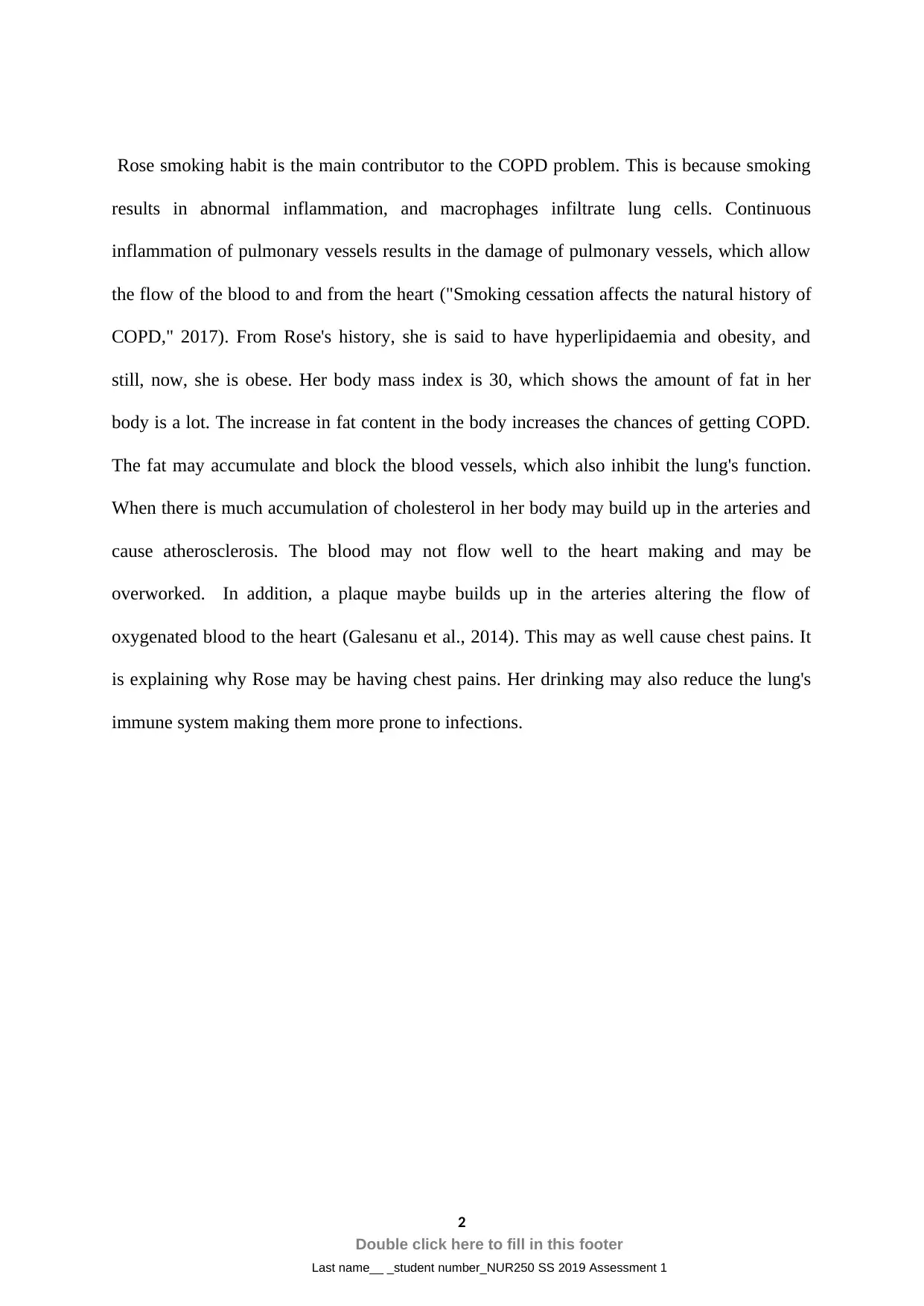
Rose smoking habit is the main contributor to the COPD problem. This is because smoking
results in abnormal inflammation, and macrophages infiltrate lung cells. Continuous
inflammation of pulmonary vessels results in the damage of pulmonary vessels, which allow
the flow of the blood to and from the heart ("Smoking cessation affects the natural history of
COPD," 2017). From Rose's history, she is said to have hyperlipidaemia and obesity, and
still, now, she is obese. Her body mass index is 30, which shows the amount of fat in her
body is a lot. The increase in fat content in the body increases the chances of getting COPD.
The fat may accumulate and block the blood vessels, which also inhibit the lung's function.
When there is much accumulation of cholesterol in her body may build up in the arteries and
cause atherosclerosis. The blood may not flow well to the heart making and may be
overworked. In addition, a plaque maybe builds up in the arteries altering the flow of
oxygenated blood to the heart (Galesanu et al., 2014). This may as well cause chest pains. It
is explaining why Rose may be having chest pains. Her drinking may also reduce the lung's
immune system making them more prone to infections.
2
Double click here to fill in this footer
Last name__ _student number_NUR250 SS 2019 Assessment 1
results in abnormal inflammation, and macrophages infiltrate lung cells. Continuous
inflammation of pulmonary vessels results in the damage of pulmonary vessels, which allow
the flow of the blood to and from the heart ("Smoking cessation affects the natural history of
COPD," 2017). From Rose's history, she is said to have hyperlipidaemia and obesity, and
still, now, she is obese. Her body mass index is 30, which shows the amount of fat in her
body is a lot. The increase in fat content in the body increases the chances of getting COPD.
The fat may accumulate and block the blood vessels, which also inhibit the lung's function.
When there is much accumulation of cholesterol in her body may build up in the arteries and
cause atherosclerosis. The blood may not flow well to the heart making and may be
overworked. In addition, a plaque maybe builds up in the arteries altering the flow of
oxygenated blood to the heart (Galesanu et al., 2014). This may as well cause chest pains. It
is explaining why Rose may be having chest pains. Her drinking may also reduce the lung's
immune system making them more prone to infections.
2
Double click here to fill in this footer
Last name__ _student number_NUR250 SS 2019 Assessment 1

3
Double click here to fill in this footer
Last name__ _student number_NUR250 SS 2019 Assessment 1
Double click here to fill in this footer
Last name__ _student number_NUR250 SS 2019 Assessment 1
⊘ This is a preview!⊘
Do you want full access?
Subscribe today to unlock all pages.

Trusted by 1+ million students worldwide
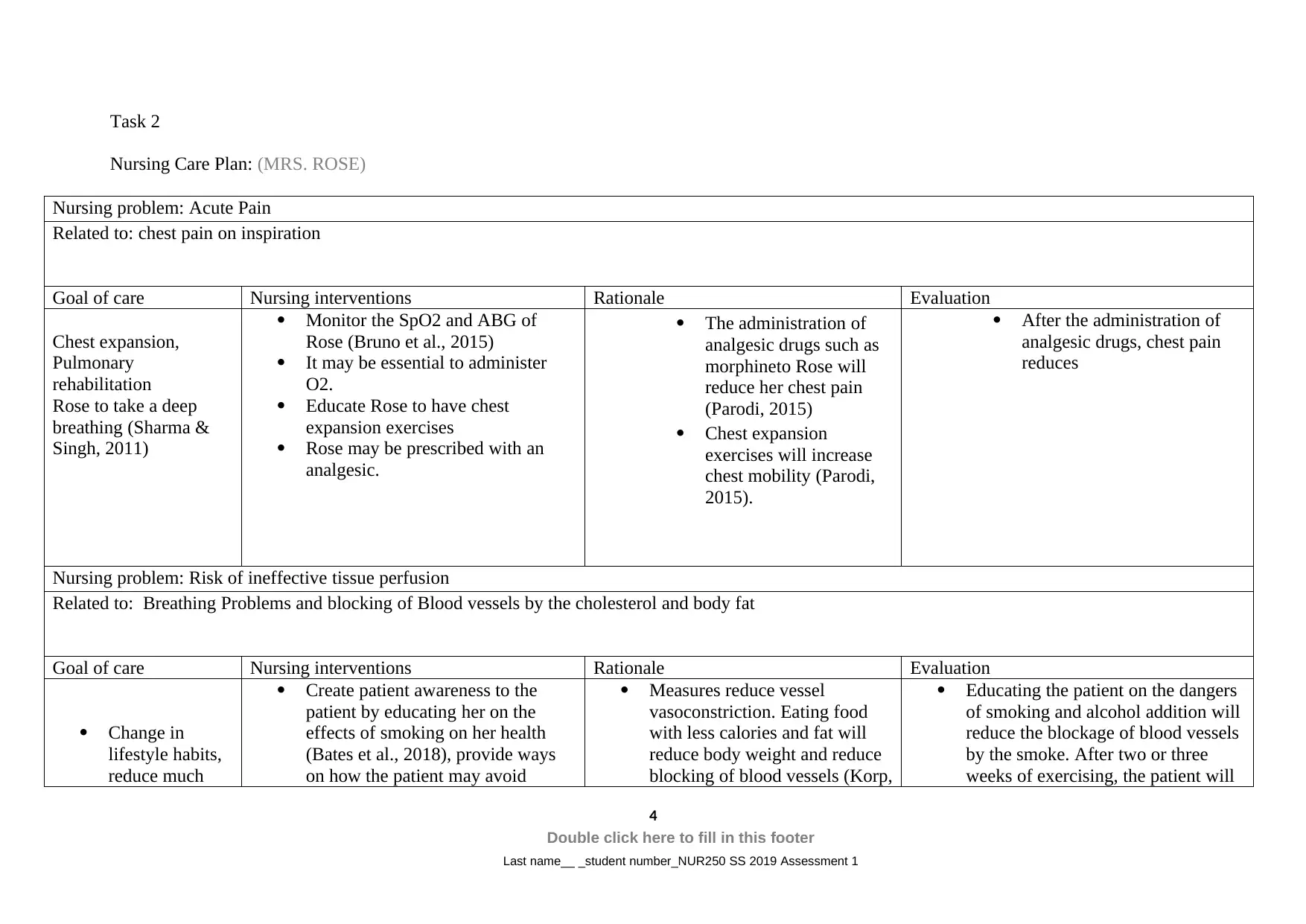
Task 2
Nursing Care Plan: (MRS. ROSE)
Nursing problem: Acute Pain
Related to: chest pain on inspiration
Goal of care Nursing interventions Rationale Evaluation
Chest expansion,
Pulmonary
rehabilitation
Rose to take a deep
breathing (Sharma &
Singh, 2011)
Monitor the SpO2 and ABG of
Rose (Bruno et al., 2015)
It may be essential to administer
O2.
Educate Rose to have chest
expansion exercises
Rose may be prescribed with an
analgesic.
The administration of
analgesic drugs such as
morphineto Rose will
reduce her chest pain
(Parodi, 2015)
Chest expansion
exercises will increase
chest mobility (Parodi,
2015).
After the administration of
analgesic drugs, chest pain
reduces
Nursing problem: Risk of ineffective tissue perfusion
Related to: Breathing Problems and blocking of Blood vessels by the cholesterol and body fat
Goal of care Nursing interventions Rationale Evaluation
Change in
lifestyle habits,
reduce much
Create patient awareness to the
patient by educating her on the
effects of smoking on her health
(Bates et al., 2018), provide ways
on how the patient may avoid
Measures reduce vessel
vasoconstriction. Eating food
with less calories and fat will
reduce body weight and reduce
blocking of blood vessels (Korp,
Educating the patient on the dangers
of smoking and alcohol addition will
reduce the blockage of blood vessels
by the smoke. After two or three
weeks of exercising, the patient will
4
Double click here to fill in this footer
Last name__ _student number_NUR250 SS 2019 Assessment 1
Nursing Care Plan: (MRS. ROSE)
Nursing problem: Acute Pain
Related to: chest pain on inspiration
Goal of care Nursing interventions Rationale Evaluation
Chest expansion,
Pulmonary
rehabilitation
Rose to take a deep
breathing (Sharma &
Singh, 2011)
Monitor the SpO2 and ABG of
Rose (Bruno et al., 2015)
It may be essential to administer
O2.
Educate Rose to have chest
expansion exercises
Rose may be prescribed with an
analgesic.
The administration of
analgesic drugs such as
morphineto Rose will
reduce her chest pain
(Parodi, 2015)
Chest expansion
exercises will increase
chest mobility (Parodi,
2015).
After the administration of
analgesic drugs, chest pain
reduces
Nursing problem: Risk of ineffective tissue perfusion
Related to: Breathing Problems and blocking of Blood vessels by the cholesterol and body fat
Goal of care Nursing interventions Rationale Evaluation
Change in
lifestyle habits,
reduce much
Create patient awareness to the
patient by educating her on the
effects of smoking on her health
(Bates et al., 2018), provide ways
on how the patient may avoid
Measures reduce vessel
vasoconstriction. Eating food
with less calories and fat will
reduce body weight and reduce
blocking of blood vessels (Korp,
Educating the patient on the dangers
of smoking and alcohol addition will
reduce the blockage of blood vessels
by the smoke. After two or three
weeks of exercising, the patient will
4
Double click here to fill in this footer
Last name__ _student number_NUR250 SS 2019 Assessment 1
Paraphrase This Document
Need a fresh take? Get an instant paraphrase of this document with our AI Paraphraser
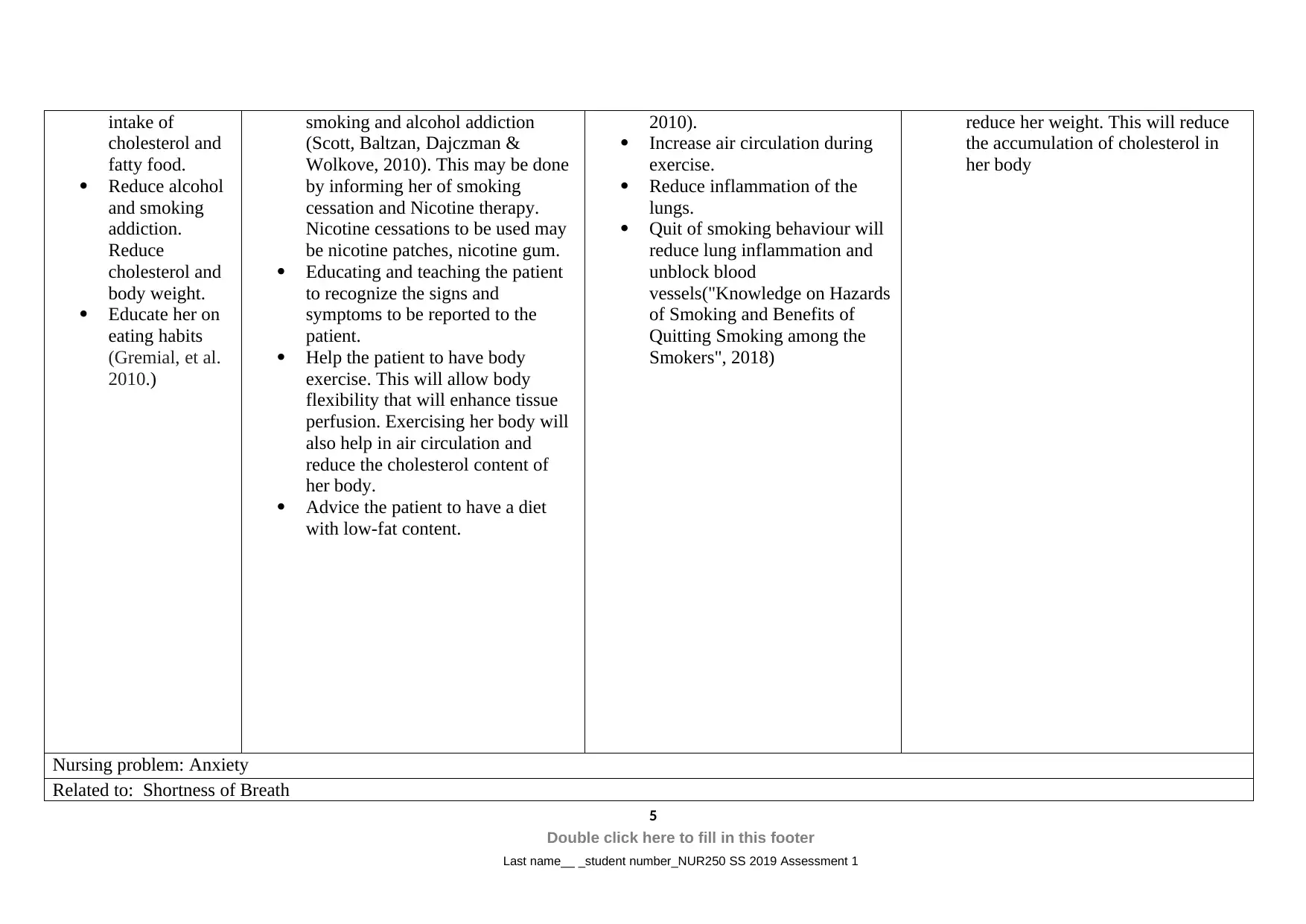
intake of
cholesterol and
fatty food.
Reduce alcohol
and smoking
addiction.
Reduce
cholesterol and
body weight.
Educate her on
eating habits
(Gremial, et al.
2010.)
smoking and alcohol addiction
(Scott, Baltzan, Dajczman &
Wolkove, 2010). This may be done
by informing her of smoking
cessation and Nicotine therapy.
Nicotine cessations to be used may
be nicotine patches, nicotine gum.
Educating and teaching the patient
to recognize the signs and
symptoms to be reported to the
patient.
Help the patient to have body
exercise. This will allow body
flexibility that will enhance tissue
perfusion. Exercising her body will
also help in air circulation and
reduce the cholesterol content of
her body.
Advice the patient to have a diet
with low-fat content.
2010).
Increase air circulation during
exercise.
Reduce inflammation of the
lungs.
Quit of smoking behaviour will
reduce lung inflammation and
unblock blood
vessels("Knowledge on Hazards
of Smoking and Benefits of
Quitting Smoking among the
Smokers", 2018)
reduce her weight. This will reduce
the accumulation of cholesterol in
her body
Nursing problem: Anxiety
Related to: Shortness of Breath
5
Double click here to fill in this footer
Last name__ _student number_NUR250 SS 2019 Assessment 1
cholesterol and
fatty food.
Reduce alcohol
and smoking
addiction.
Reduce
cholesterol and
body weight.
Educate her on
eating habits
(Gremial, et al.
2010.)
smoking and alcohol addiction
(Scott, Baltzan, Dajczman &
Wolkove, 2010). This may be done
by informing her of smoking
cessation and Nicotine therapy.
Nicotine cessations to be used may
be nicotine patches, nicotine gum.
Educating and teaching the patient
to recognize the signs and
symptoms to be reported to the
patient.
Help the patient to have body
exercise. This will allow body
flexibility that will enhance tissue
perfusion. Exercising her body will
also help in air circulation and
reduce the cholesterol content of
her body.
Advice the patient to have a diet
with low-fat content.
2010).
Increase air circulation during
exercise.
Reduce inflammation of the
lungs.
Quit of smoking behaviour will
reduce lung inflammation and
unblock blood
vessels("Knowledge on Hazards
of Smoking and Benefits of
Quitting Smoking among the
Smokers", 2018)
reduce her weight. This will reduce
the accumulation of cholesterol in
her body
Nursing problem: Anxiety
Related to: Shortness of Breath
5
Double click here to fill in this footer
Last name__ _student number_NUR250 SS 2019 Assessment 1
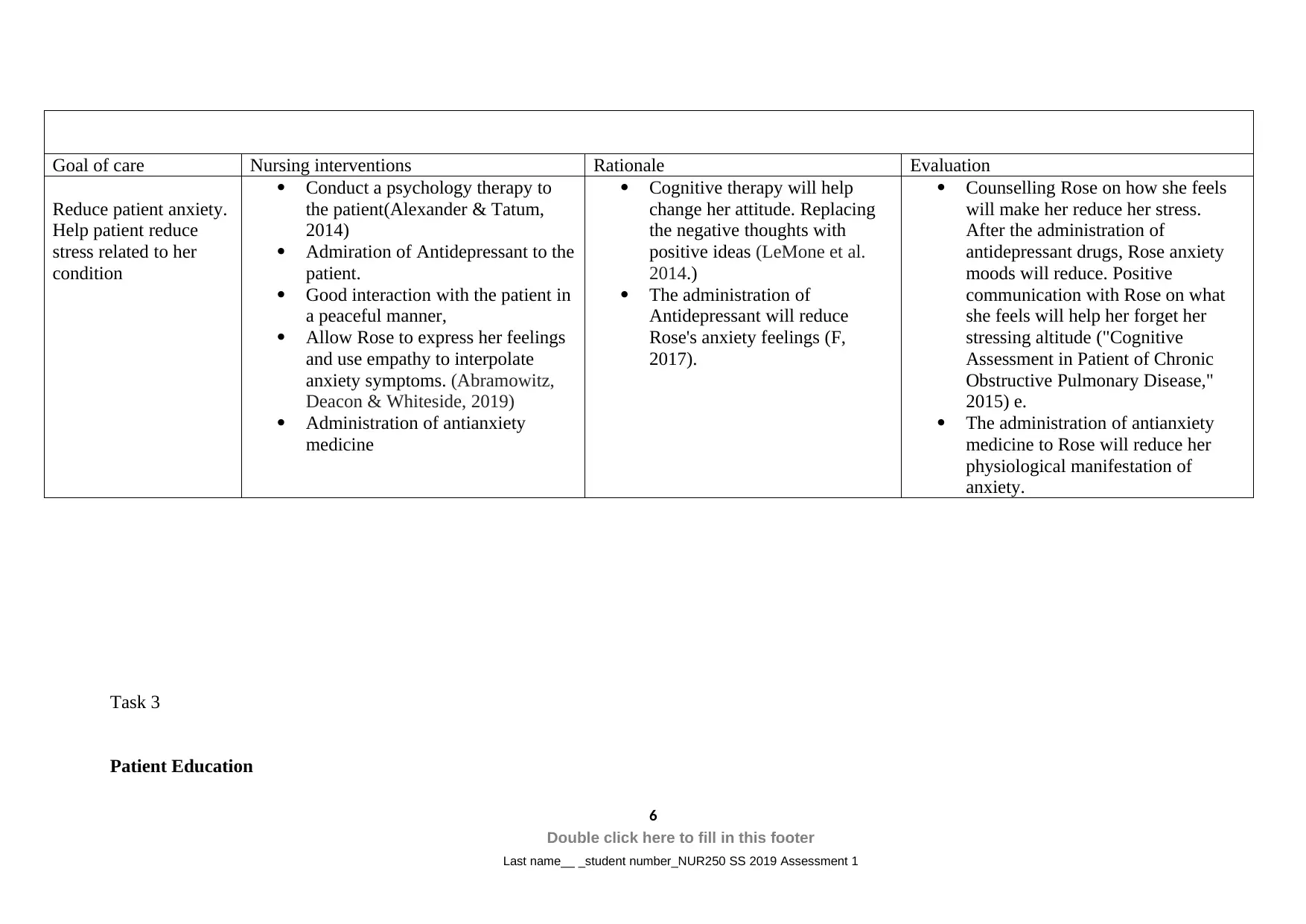
Goal of care Nursing interventions Rationale Evaluation
Reduce patient anxiety.
Help patient reduce
stress related to her
condition
Conduct a psychology therapy to
the patient(Alexander & Tatum,
2014)
Admiration of Antidepressant to the
patient.
Good interaction with the patient in
a peaceful manner,
Allow Rose to express her feelings
and use empathy to interpolate
anxiety symptoms. (Abramowitz,
Deacon & Whiteside, 2019)
Administration of antianxiety
medicine
Cognitive therapy will help
change her attitude. Replacing
the negative thoughts with
positive ideas (LeMone et al.
2014.)
The administration of
Antidepressant will reduce
Rose's anxiety feelings (F,
2017).
Counselling Rose on how she feels
will make her reduce her stress.
After the administration of
antidepressant drugs, Rose anxiety
moods will reduce. Positive
communication with Rose on what
she feels will help her forget her
stressing altitude ("Cognitive
Assessment in Patient of Chronic
Obstructive Pulmonary Disease,"
2015) e.
The administration of antianxiety
medicine to Rose will reduce her
physiological manifestation of
anxiety.
Task 3
Patient Education
6
Double click here to fill in this footer
Last name__ _student number_NUR250 SS 2019 Assessment 1
Reduce patient anxiety.
Help patient reduce
stress related to her
condition
Conduct a psychology therapy to
the patient(Alexander & Tatum,
2014)
Admiration of Antidepressant to the
patient.
Good interaction with the patient in
a peaceful manner,
Allow Rose to express her feelings
and use empathy to interpolate
anxiety symptoms. (Abramowitz,
Deacon & Whiteside, 2019)
Administration of antianxiety
medicine
Cognitive therapy will help
change her attitude. Replacing
the negative thoughts with
positive ideas (LeMone et al.
2014.)
The administration of
Antidepressant will reduce
Rose's anxiety feelings (F,
2017).
Counselling Rose on how she feels
will make her reduce her stress.
After the administration of
antidepressant drugs, Rose anxiety
moods will reduce. Positive
communication with Rose on what
she feels will help her forget her
stressing altitude ("Cognitive
Assessment in Patient of Chronic
Obstructive Pulmonary Disease,"
2015) e.
The administration of antianxiety
medicine to Rose will reduce her
physiological manifestation of
anxiety.
Task 3
Patient Education
6
Double click here to fill in this footer
Last name__ _student number_NUR250 SS 2019 Assessment 1
⊘ This is a preview!⊘
Do you want full access?
Subscribe today to unlock all pages.

Trusted by 1+ million students worldwide
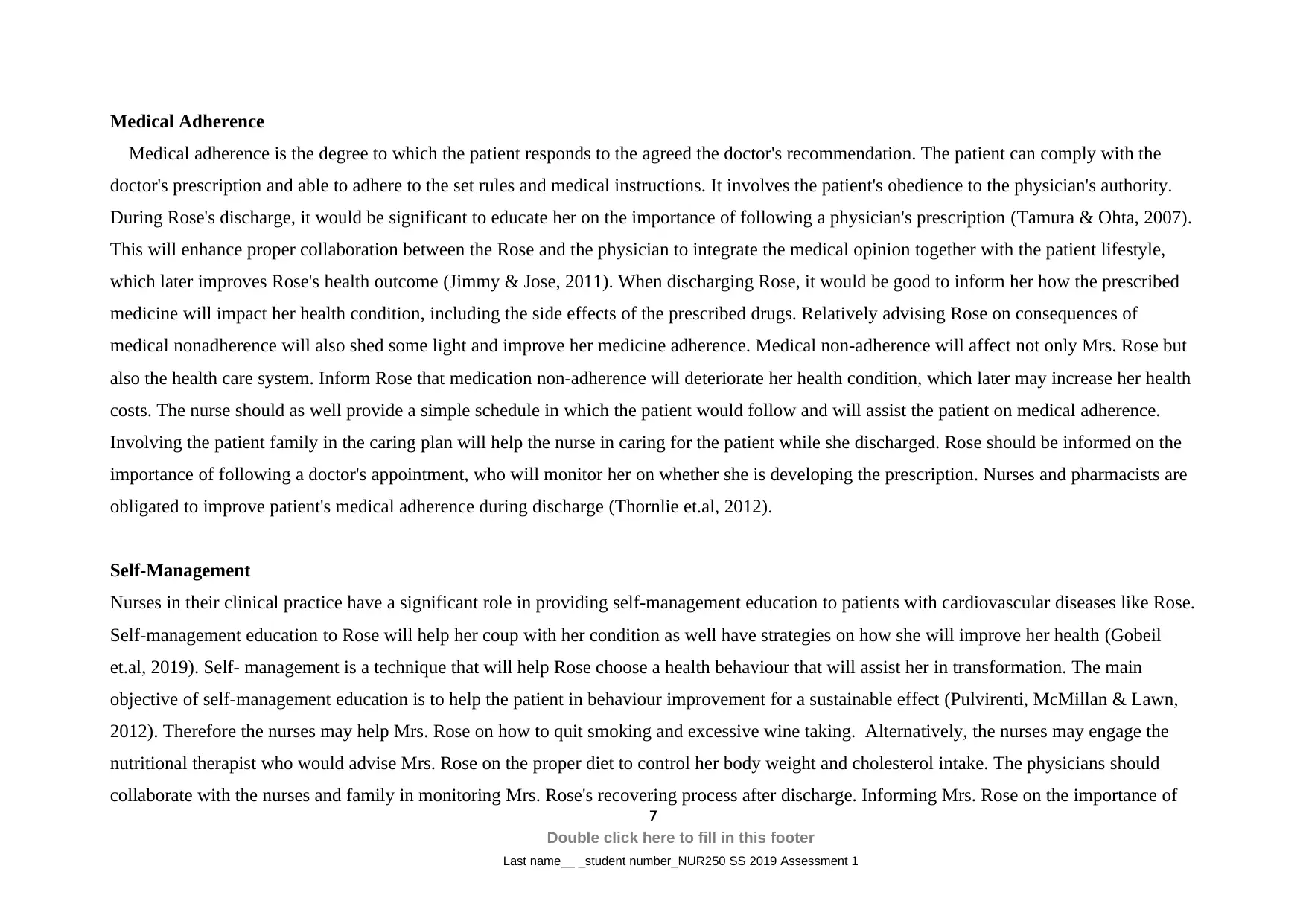
Medical Adherence
Medical adherence is the degree to which the patient responds to the agreed the doctor's recommendation. The patient can comply with the
doctor's prescription and able to adhere to the set rules and medical instructions. It involves the patient's obedience to the physician's authority.
During Rose's discharge, it would be significant to educate her on the importance of following a physician's prescription (Tamura & Ohta, 2007).
This will enhance proper collaboration between the Rose and the physician to integrate the medical opinion together with the patient lifestyle,
which later improves Rose's health outcome (Jimmy & Jose, 2011). When discharging Rose, it would be good to inform her how the prescribed
medicine will impact her health condition, including the side effects of the prescribed drugs. Relatively advising Rose on consequences of
medical nonadherence will also shed some light and improve her medicine adherence. Medical non-adherence will affect not only Mrs. Rose but
also the health care system. Inform Rose that medication non-adherence will deteriorate her health condition, which later may increase her health
costs. The nurse should as well provide a simple schedule in which the patient would follow and will assist the patient on medical adherence.
Involving the patient family in the caring plan will help the nurse in caring for the patient while she discharged. Rose should be informed on the
importance of following a doctor's appointment, who will monitor her on whether she is developing the prescription. Nurses and pharmacists are
obligated to improve patient's medical adherence during discharge (Thornlie et.al, 2012).
Self-Management
Nurses in their clinical practice have a significant role in providing self-management education to patients with cardiovascular diseases like Rose.
Self-management education to Rose will help her coup with her condition as well have strategies on how she will improve her health (Gobeil
et.al, 2019). Self- management is a technique that will help Rose choose a health behaviour that will assist her in transformation. The main
objective of self-management education is to help the patient in behaviour improvement for a sustainable effect (Pulvirenti, McMillan & Lawn,
2012). Therefore the nurses may help Mrs. Rose on how to quit smoking and excessive wine taking. Alternatively, the nurses may engage the
nutritional therapist who would advise Mrs. Rose on the proper diet to control her body weight and cholesterol intake. The physicians should
collaborate with the nurses and family in monitoring Mrs. Rose's recovering process after discharge. Informing Mrs. Rose on the importance of
7
Double click here to fill in this footer
Last name__ _student number_NUR250 SS 2019 Assessment 1
Medical adherence is the degree to which the patient responds to the agreed the doctor's recommendation. The patient can comply with the
doctor's prescription and able to adhere to the set rules and medical instructions. It involves the patient's obedience to the physician's authority.
During Rose's discharge, it would be significant to educate her on the importance of following a physician's prescription (Tamura & Ohta, 2007).
This will enhance proper collaboration between the Rose and the physician to integrate the medical opinion together with the patient lifestyle,
which later improves Rose's health outcome (Jimmy & Jose, 2011). When discharging Rose, it would be good to inform her how the prescribed
medicine will impact her health condition, including the side effects of the prescribed drugs. Relatively advising Rose on consequences of
medical nonadherence will also shed some light and improve her medicine adherence. Medical non-adherence will affect not only Mrs. Rose but
also the health care system. Inform Rose that medication non-adherence will deteriorate her health condition, which later may increase her health
costs. The nurse should as well provide a simple schedule in which the patient would follow and will assist the patient on medical adherence.
Involving the patient family in the caring plan will help the nurse in caring for the patient while she discharged. Rose should be informed on the
importance of following a doctor's appointment, who will monitor her on whether she is developing the prescription. Nurses and pharmacists are
obligated to improve patient's medical adherence during discharge (Thornlie et.al, 2012).
Self-Management
Nurses in their clinical practice have a significant role in providing self-management education to patients with cardiovascular diseases like Rose.
Self-management education to Rose will help her coup with her condition as well have strategies on how she will improve her health (Gobeil
et.al, 2019). Self- management is a technique that will help Rose choose a health behaviour that will assist her in transformation. The main
objective of self-management education is to help the patient in behaviour improvement for a sustainable effect (Pulvirenti, McMillan & Lawn,
2012). Therefore the nurses may help Mrs. Rose on how to quit smoking and excessive wine taking. Alternatively, the nurses may engage the
nutritional therapist who would advise Mrs. Rose on the proper diet to control her body weight and cholesterol intake. The physicians should
collaborate with the nurses and family in monitoring Mrs. Rose's recovering process after discharge. Informing Mrs. Rose on the importance of
7
Double click here to fill in this footer
Last name__ _student number_NUR250 SS 2019 Assessment 1
Paraphrase This Document
Need a fresh take? Get an instant paraphrase of this document with our AI Paraphraser
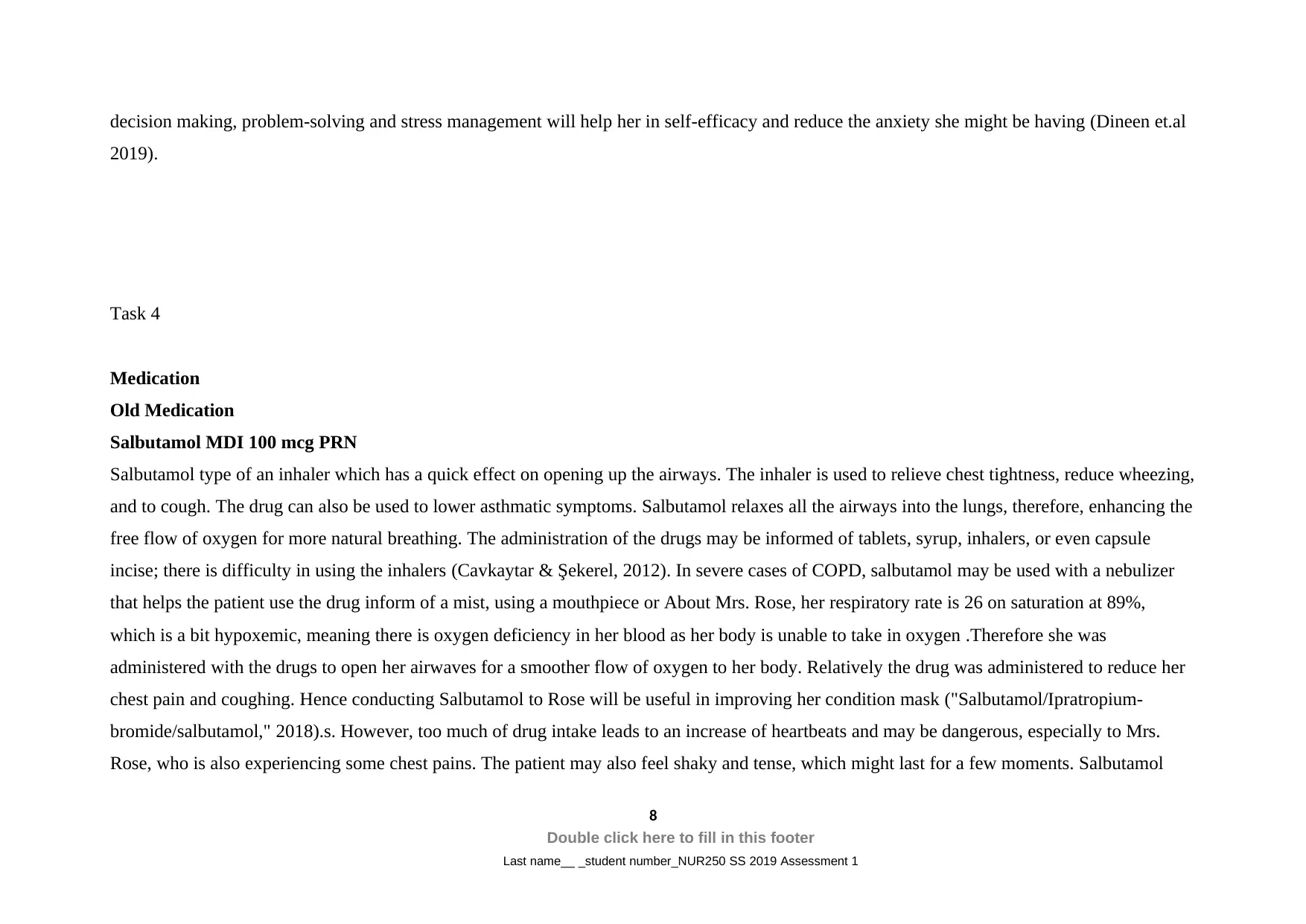
decision making, problem-solving and stress management will help her in self-efficacy and reduce the anxiety she might be having (Dineen et.al
2019).
Task 4
Medication
Old Medication
Salbutamol MDI 100 mcg PRN
Salbutamol type of an inhaler which has a quick effect on opening up the airways. The inhaler is used to relieve chest tightness, reduce wheezing,
and to cough. The drug can also be used to lower asthmatic symptoms. Salbutamol relaxes all the airways into the lungs, therefore, enhancing the
free flow of oxygen for more natural breathing. The administration of the drugs may be informed of tablets, syrup, inhalers, or even capsule
incise; there is difficulty in using the inhalers (Cavkaytar & Şekerel, 2012). In severe cases of COPD, salbutamol may be used with a nebulizer
that helps the patient use the drug inform of a mist, using a mouthpiece or About Mrs. Rose, her respiratory rate is 26 on saturation at 89%,
which is a bit hypoxemic, meaning there is oxygen deficiency in her blood as her body is unable to take in oxygen .Therefore she was
administered with the drugs to open her airwaves for a smoother flow of oxygen to her body. Relatively the drug was administered to reduce her
chest pain and coughing. Hence conducting Salbutamol to Rose will be useful in improving her condition mask ("Salbutamol/Ipratropium-
bromide/salbutamol," 2018).s. However, too much of drug intake leads to an increase of heartbeats and may be dangerous, especially to Mrs.
Rose, who is also experiencing some chest pains. The patient may also feel shaky and tense, which might last for a few moments. Salbutamol
8
Double click here to fill in this footer
Last name__ _student number_NUR250 SS 2019 Assessment 1
2019).
Task 4
Medication
Old Medication
Salbutamol MDI 100 mcg PRN
Salbutamol type of an inhaler which has a quick effect on opening up the airways. The inhaler is used to relieve chest tightness, reduce wheezing,
and to cough. The drug can also be used to lower asthmatic symptoms. Salbutamol relaxes all the airways into the lungs, therefore, enhancing the
free flow of oxygen for more natural breathing. The administration of the drugs may be informed of tablets, syrup, inhalers, or even capsule
incise; there is difficulty in using the inhalers (Cavkaytar & Şekerel, 2012). In severe cases of COPD, salbutamol may be used with a nebulizer
that helps the patient use the drug inform of a mist, using a mouthpiece or About Mrs. Rose, her respiratory rate is 26 on saturation at 89%,
which is a bit hypoxemic, meaning there is oxygen deficiency in her blood as her body is unable to take in oxygen .Therefore she was
administered with the drugs to open her airwaves for a smoother flow of oxygen to her body. Relatively the drug was administered to reduce her
chest pain and coughing. Hence conducting Salbutamol to Rose will be useful in improving her condition mask ("Salbutamol/Ipratropium-
bromide/salbutamol," 2018).s. However, too much of drug intake leads to an increase of heartbeats and may be dangerous, especially to Mrs.
Rose, who is also experiencing some chest pains. The patient may also feel shaky and tense, which might last for a few moments. Salbutamol
8
Double click here to fill in this footer
Last name__ _student number_NUR250 SS 2019 Assessment 1
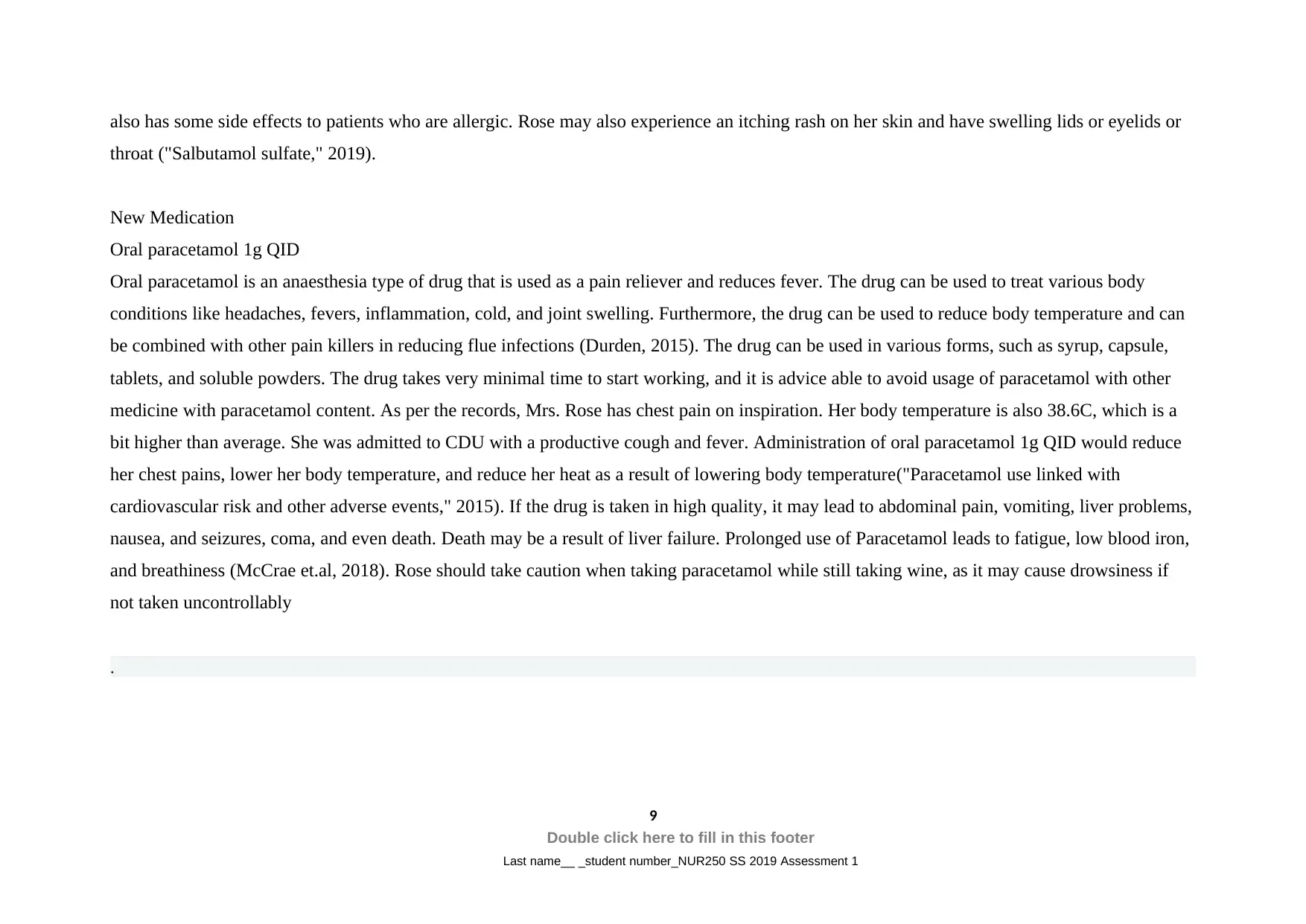
also has some side effects to patients who are allergic. Rose may also experience an itching rash on her skin and have swelling lids or eyelids or
throat ("Salbutamol sulfate," 2019).
New Medication
Oral paracetamol 1g QID
Oral paracetamol is an anaesthesia type of drug that is used as a pain reliever and reduces fever. The drug can be used to treat various body
conditions like headaches, fevers, inflammation, cold, and joint swelling. Furthermore, the drug can be used to reduce body temperature and can
be combined with other pain killers in reducing flue infections (Durden, 2015). The drug can be used in various forms, such as syrup, capsule,
tablets, and soluble powders. The drug takes very minimal time to start working, and it is advice able to avoid usage of paracetamol with other
medicine with paracetamol content. As per the records, Mrs. Rose has chest pain on inspiration. Her body temperature is also 38.6C, which is a
bit higher than average. She was admitted to CDU with a productive cough and fever. Administration of oral paracetamol 1g QID would reduce
her chest pains, lower her body temperature, and reduce her heat as a result of lowering body temperature("Paracetamol use linked with
cardiovascular risk and other adverse events," 2015). If the drug is taken in high quality, it may lead to abdominal pain, vomiting, liver problems,
nausea, and seizures, coma, and even death. Death may be a result of liver failure. Prolonged use of Paracetamol leads to fatigue, low blood iron,
and breathiness (McCrae et.al, 2018). Rose should take caution when taking paracetamol while still taking wine, as it may cause drowsiness if
not taken uncontrollably
.
9
Double click here to fill in this footer
Last name__ _student number_NUR250 SS 2019 Assessment 1
throat ("Salbutamol sulfate," 2019).
New Medication
Oral paracetamol 1g QID
Oral paracetamol is an anaesthesia type of drug that is used as a pain reliever and reduces fever. The drug can be used to treat various body
conditions like headaches, fevers, inflammation, cold, and joint swelling. Furthermore, the drug can be used to reduce body temperature and can
be combined with other pain killers in reducing flue infections (Durden, 2015). The drug can be used in various forms, such as syrup, capsule,
tablets, and soluble powders. The drug takes very minimal time to start working, and it is advice able to avoid usage of paracetamol with other
medicine with paracetamol content. As per the records, Mrs. Rose has chest pain on inspiration. Her body temperature is also 38.6C, which is a
bit higher than average. She was admitted to CDU with a productive cough and fever. Administration of oral paracetamol 1g QID would reduce
her chest pains, lower her body temperature, and reduce her heat as a result of lowering body temperature("Paracetamol use linked with
cardiovascular risk and other adverse events," 2015). If the drug is taken in high quality, it may lead to abdominal pain, vomiting, liver problems,
nausea, and seizures, coma, and even death. Death may be a result of liver failure. Prolonged use of Paracetamol leads to fatigue, low blood iron,
and breathiness (McCrae et.al, 2018). Rose should take caution when taking paracetamol while still taking wine, as it may cause drowsiness if
not taken uncontrollably
.
9
Double click here to fill in this footer
Last name__ _student number_NUR250 SS 2019 Assessment 1
⊘ This is a preview!⊘
Do you want full access?
Subscribe today to unlock all pages.

Trusted by 1+ million students worldwide
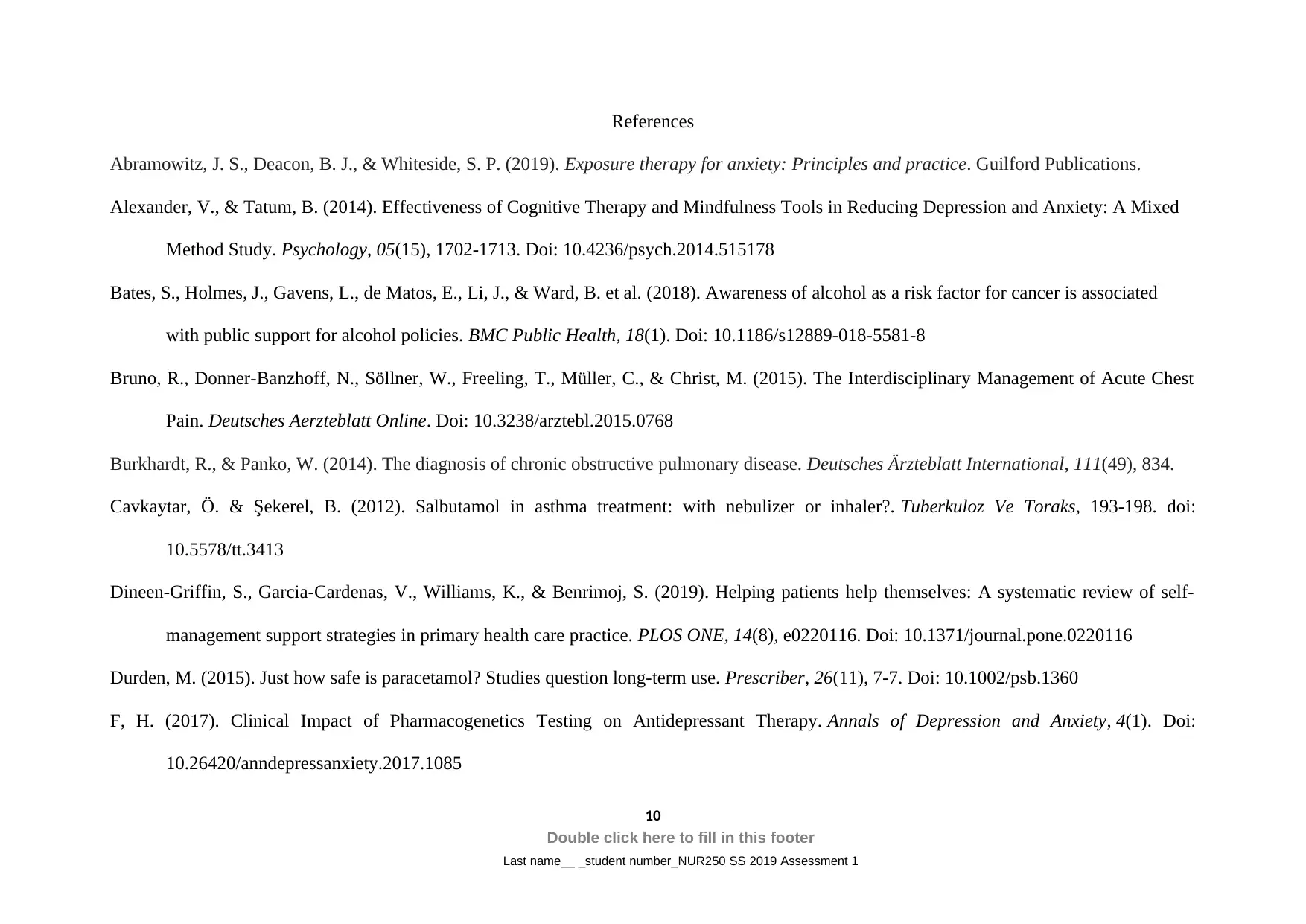
References
Abramowitz, J. S., Deacon, B. J., & Whiteside, S. P. (2019). Exposure therapy for anxiety: Principles and practice. Guilford Publications.
Alexander, V., & Tatum, B. (2014). Effectiveness of Cognitive Therapy and Mindfulness Tools in Reducing Depression and Anxiety: A Mixed
Method Study. Psychology, 05(15), 1702-1713. Doi: 10.4236/psych.2014.515178
Bates, S., Holmes, J., Gavens, L., de Matos, E., Li, J., & Ward, B. et al. (2018). Awareness of alcohol as a risk factor for cancer is associated
with public support for alcohol policies. BMC Public Health, 18(1). Doi: 10.1186/s12889-018-5581-8
Bruno, R., Donner-Banzhoff, N., Söllner, W., Freeling, T., Müller, C., & Christ, M. (2015). The Interdisciplinary Management of Acute Chest
Pain. Deutsches Aerzteblatt Online. Doi: 10.3238/arztebl.2015.0768
Burkhardt, R., & Panko, W. (2014). The diagnosis of chronic obstructive pulmonary disease. Deutsches Ärzteblatt International, 111(49), 834.
Cavkaytar, Ö. & Şekerel, B. (2012). Salbutamol in asthma treatment: with nebulizer or inhaler?. Tuberkuloz Ve Toraks, 193-198. doi:
10.5578/tt.3413
Dineen-Griffin, S., Garcia-Cardenas, V., Williams, K., & Benrimoj, S. (2019). Helping patients help themselves: A systematic review of self-
management support strategies in primary health care practice. PLOS ONE, 14(8), e0220116. Doi: 10.1371/journal.pone.0220116
Durden, M. (2015). Just how safe is paracetamol? Studies question long-term use. Prescriber, 26(11), 7-7. Doi: 10.1002/psb.1360
F, H. (2017). Clinical Impact of Pharmacogenetics Testing on Antidepressant Therapy. Annals of Depression and Anxiety, 4(1). Doi:
10.26420/anndepressanxiety.2017.1085
10
Double click here to fill in this footer
Last name__ _student number_NUR250 SS 2019 Assessment 1
Abramowitz, J. S., Deacon, B. J., & Whiteside, S. P. (2019). Exposure therapy for anxiety: Principles and practice. Guilford Publications.
Alexander, V., & Tatum, B. (2014). Effectiveness of Cognitive Therapy and Mindfulness Tools in Reducing Depression and Anxiety: A Mixed
Method Study. Psychology, 05(15), 1702-1713. Doi: 10.4236/psych.2014.515178
Bates, S., Holmes, J., Gavens, L., de Matos, E., Li, J., & Ward, B. et al. (2018). Awareness of alcohol as a risk factor for cancer is associated
with public support for alcohol policies. BMC Public Health, 18(1). Doi: 10.1186/s12889-018-5581-8
Bruno, R., Donner-Banzhoff, N., Söllner, W., Freeling, T., Müller, C., & Christ, M. (2015). The Interdisciplinary Management of Acute Chest
Pain. Deutsches Aerzteblatt Online. Doi: 10.3238/arztebl.2015.0768
Burkhardt, R., & Panko, W. (2014). The diagnosis of chronic obstructive pulmonary disease. Deutsches Ärzteblatt International, 111(49), 834.
Cavkaytar, Ö. & Şekerel, B. (2012). Salbutamol in asthma treatment: with nebulizer or inhaler?. Tuberkuloz Ve Toraks, 193-198. doi:
10.5578/tt.3413
Dineen-Griffin, S., Garcia-Cardenas, V., Williams, K., & Benrimoj, S. (2019). Helping patients help themselves: A systematic review of self-
management support strategies in primary health care practice. PLOS ONE, 14(8), e0220116. Doi: 10.1371/journal.pone.0220116
Durden, M. (2015). Just how safe is paracetamol? Studies question long-term use. Prescriber, 26(11), 7-7. Doi: 10.1002/psb.1360
F, H. (2017). Clinical Impact of Pharmacogenetics Testing on Antidepressant Therapy. Annals of Depression and Anxiety, 4(1). Doi:
10.26420/anndepressanxiety.2017.1085
10
Double click here to fill in this footer
Last name__ _student number_NUR250 SS 2019 Assessment 1
Paraphrase This Document
Need a fresh take? Get an instant paraphrase of this document with our AI Paraphraser
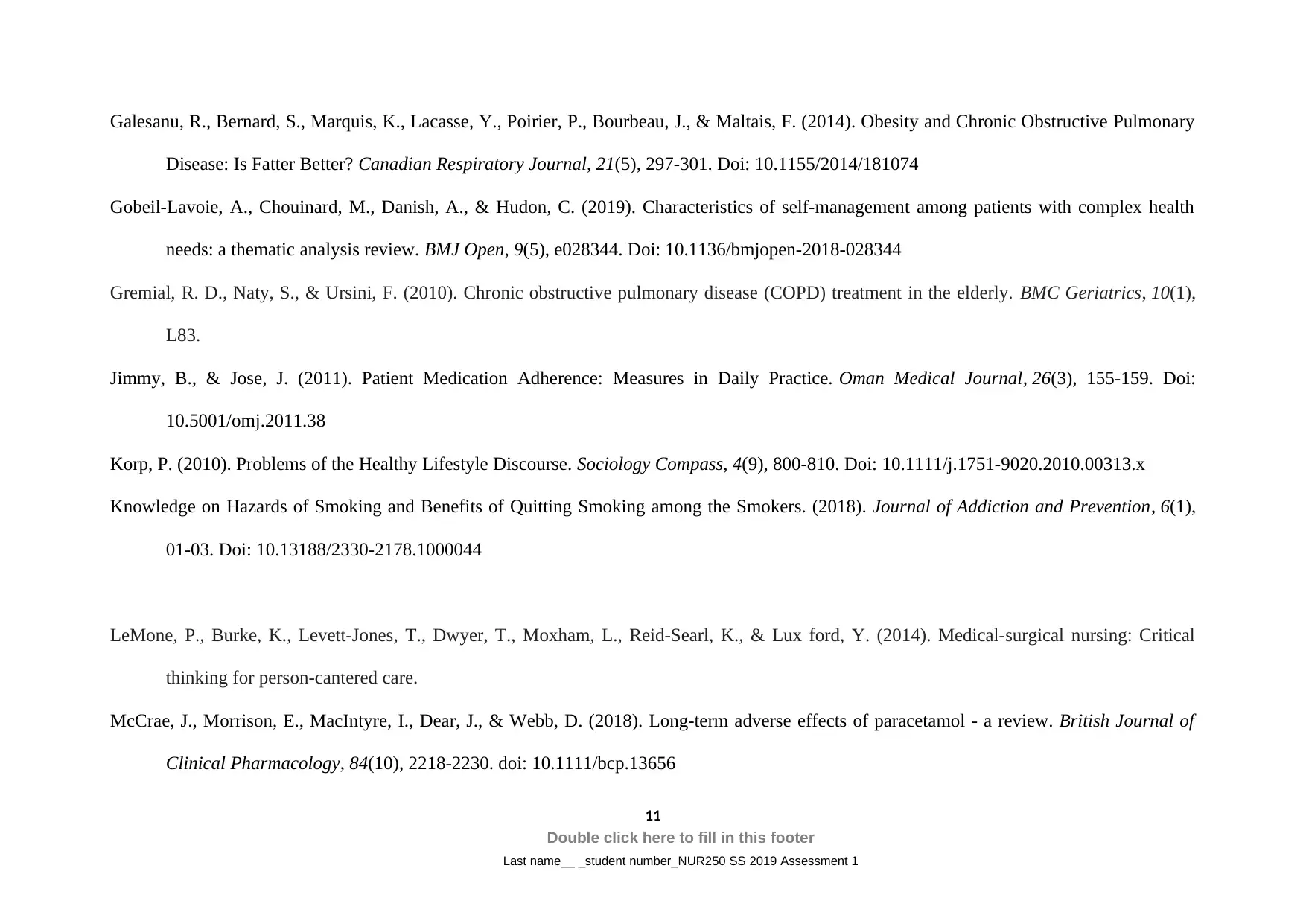
Galesanu, R., Bernard, S., Marquis, K., Lacasse, Y., Poirier, P., Bourbeau, J., & Maltais, F. (2014). Obesity and Chronic Obstructive Pulmonary
Disease: Is Fatter Better? Canadian Respiratory Journal, 21(5), 297-301. Doi: 10.1155/2014/181074
Gobeil-Lavoie, A., Chouinard, M., Danish, A., & Hudon, C. (2019). Characteristics of self-management among patients with complex health
needs: a thematic analysis review. BMJ Open, 9(5), e028344. Doi: 10.1136/bmjopen-2018-028344
Gremial, R. D., Naty, S., & Ursini, F. (2010). Chronic obstructive pulmonary disease (COPD) treatment in the elderly. BMC Geriatrics, 10(1),
L83.
Jimmy, B., & Jose, J. (2011). Patient Medication Adherence: Measures in Daily Practice. Oman Medical Journal, 26(3), 155-159. Doi:
10.5001/omj.2011.38
Korp, P. (2010). Problems of the Healthy Lifestyle Discourse. Sociology Compass, 4(9), 800-810. Doi: 10.1111/j.1751-9020.2010.00313.x
Knowledge on Hazards of Smoking and Benefits of Quitting Smoking among the Smokers. (2018). Journal of Addiction and Prevention, 6(1),
01-03. Doi: 10.13188/2330-2178.1000044
LeMone, P., Burke, K., Levett-Jones, T., Dwyer, T., Moxham, L., Reid-Searl, K., & Lux ford, Y. (2014). Medical-surgical nursing: Critical
thinking for person-cantered care.
McCrae, J., Morrison, E., MacIntyre, I., Dear, J., & Webb, D. (2018). Long-term adverse effects of paracetamol - a review. British Journal of
Clinical Pharmacology, 84(10), 2218-2230. doi: 10.1111/bcp.13656
11
Double click here to fill in this footer
Last name__ _student number_NUR250 SS 2019 Assessment 1
Disease: Is Fatter Better? Canadian Respiratory Journal, 21(5), 297-301. Doi: 10.1155/2014/181074
Gobeil-Lavoie, A., Chouinard, M., Danish, A., & Hudon, C. (2019). Characteristics of self-management among patients with complex health
needs: a thematic analysis review. BMJ Open, 9(5), e028344. Doi: 10.1136/bmjopen-2018-028344
Gremial, R. D., Naty, S., & Ursini, F. (2010). Chronic obstructive pulmonary disease (COPD) treatment in the elderly. BMC Geriatrics, 10(1),
L83.
Jimmy, B., & Jose, J. (2011). Patient Medication Adherence: Measures in Daily Practice. Oman Medical Journal, 26(3), 155-159. Doi:
10.5001/omj.2011.38
Korp, P. (2010). Problems of the Healthy Lifestyle Discourse. Sociology Compass, 4(9), 800-810. Doi: 10.1111/j.1751-9020.2010.00313.x
Knowledge on Hazards of Smoking and Benefits of Quitting Smoking among the Smokers. (2018). Journal of Addiction and Prevention, 6(1),
01-03. Doi: 10.13188/2330-2178.1000044
LeMone, P., Burke, K., Levett-Jones, T., Dwyer, T., Moxham, L., Reid-Searl, K., & Lux ford, Y. (2014). Medical-surgical nursing: Critical
thinking for person-cantered care.
McCrae, J., Morrison, E., MacIntyre, I., Dear, J., & Webb, D. (2018). Long-term adverse effects of paracetamol - a review. British Journal of
Clinical Pharmacology, 84(10), 2218-2230. doi: 10.1111/bcp.13656
11
Double click here to fill in this footer
Last name__ _student number_NUR250 SS 2019 Assessment 1
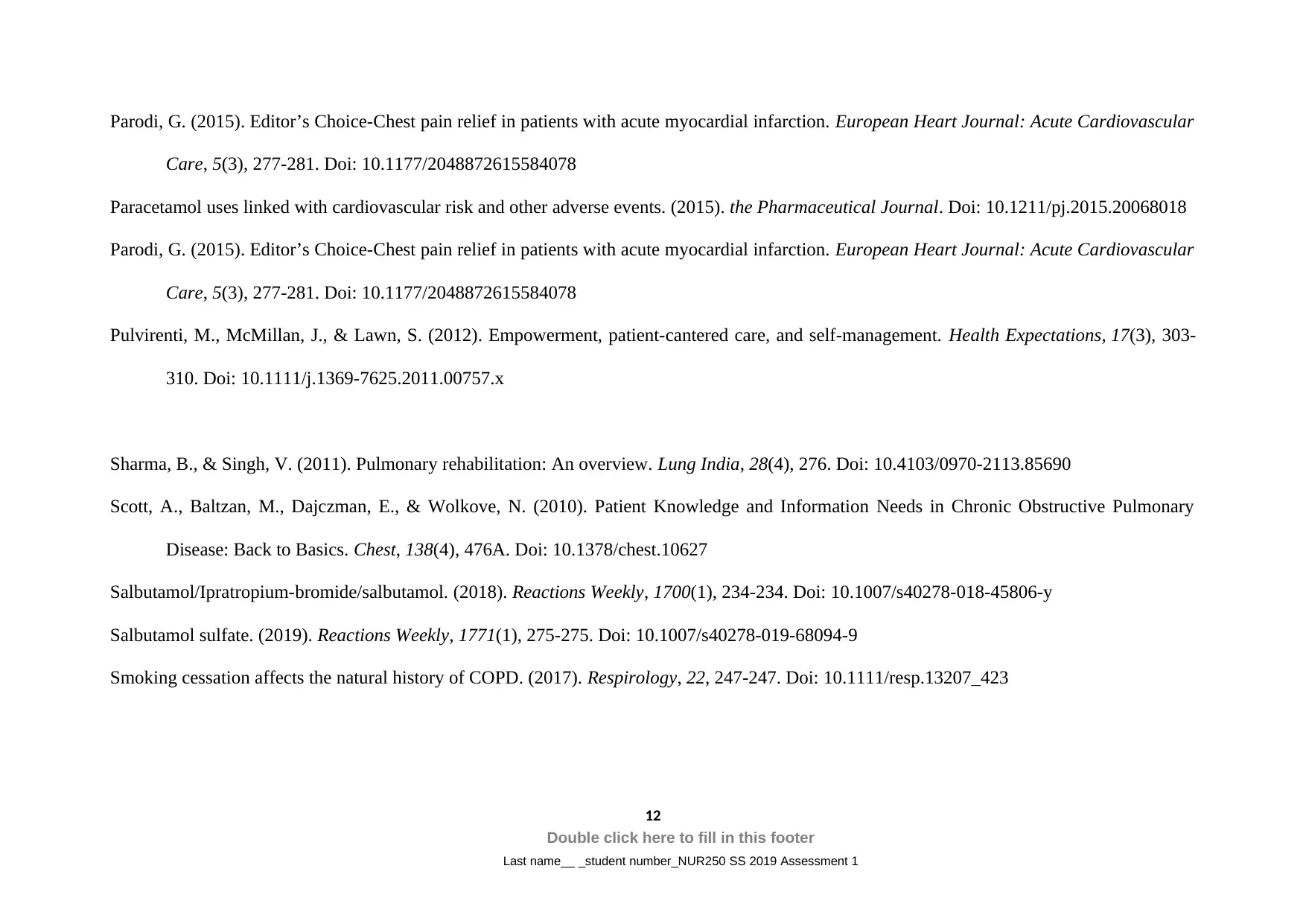
Parodi, G. (2015). Editor’s Choice-Chest pain relief in patients with acute myocardial infarction. European Heart Journal: Acute Cardiovascular
Care, 5(3), 277-281. Doi: 10.1177/2048872615584078
Paracetamol uses linked with cardiovascular risk and other adverse events. (2015). the Pharmaceutical Journal. Doi: 10.1211/pj.2015.20068018
Parodi, G. (2015). Editor’s Choice-Chest pain relief in patients with acute myocardial infarction. European Heart Journal: Acute Cardiovascular
Care, 5(3), 277-281. Doi: 10.1177/2048872615584078
Pulvirenti, M., McMillan, J., & Lawn, S. (2012). Empowerment, patient-cantered care, and self-management. Health Expectations, 17(3), 303-
310. Doi: 10.1111/j.1369-7625.2011.00757.x
Sharma, B., & Singh, V. (2011). Pulmonary rehabilitation: An overview. Lung India, 28(4), 276. Doi: 10.4103/0970-2113.85690
Scott, A., Baltzan, M., Dajczman, E., & Wolkove, N. (2010). Patient Knowledge and Information Needs in Chronic Obstructive Pulmonary
Disease: Back to Basics. Chest, 138(4), 476A. Doi: 10.1378/chest.10627
Salbutamol/Ipratropium-bromide/salbutamol. (2018). Reactions Weekly, 1700(1), 234-234. Doi: 10.1007/s40278-018-45806-y
Salbutamol sulfate. (2019). Reactions Weekly, 1771(1), 275-275. Doi: 10.1007/s40278-019-68094-9
Smoking cessation affects the natural history of COPD. (2017). Respirology, 22, 247-247. Doi: 10.1111/resp.13207_423
12
Double click here to fill in this footer
Last name__ _student number_NUR250 SS 2019 Assessment 1
Care, 5(3), 277-281. Doi: 10.1177/2048872615584078
Paracetamol uses linked with cardiovascular risk and other adverse events. (2015). the Pharmaceutical Journal. Doi: 10.1211/pj.2015.20068018
Parodi, G. (2015). Editor’s Choice-Chest pain relief in patients with acute myocardial infarction. European Heart Journal: Acute Cardiovascular
Care, 5(3), 277-281. Doi: 10.1177/2048872615584078
Pulvirenti, M., McMillan, J., & Lawn, S. (2012). Empowerment, patient-cantered care, and self-management. Health Expectations, 17(3), 303-
310. Doi: 10.1111/j.1369-7625.2011.00757.x
Sharma, B., & Singh, V. (2011). Pulmonary rehabilitation: An overview. Lung India, 28(4), 276. Doi: 10.4103/0970-2113.85690
Scott, A., Baltzan, M., Dajczman, E., & Wolkove, N. (2010). Patient Knowledge and Information Needs in Chronic Obstructive Pulmonary
Disease: Back to Basics. Chest, 138(4), 476A. Doi: 10.1378/chest.10627
Salbutamol/Ipratropium-bromide/salbutamol. (2018). Reactions Weekly, 1700(1), 234-234. Doi: 10.1007/s40278-018-45806-y
Salbutamol sulfate. (2019). Reactions Weekly, 1771(1), 275-275. Doi: 10.1007/s40278-019-68094-9
Smoking cessation affects the natural history of COPD. (2017). Respirology, 22, 247-247. Doi: 10.1111/resp.13207_423
12
Double click here to fill in this footer
Last name__ _student number_NUR250 SS 2019 Assessment 1
⊘ This is a preview!⊘
Do you want full access?
Subscribe today to unlock all pages.

Trusted by 1+ million students worldwide
1 out of 13
Related Documents
Your All-in-One AI-Powered Toolkit for Academic Success.
+13062052269
info@desklib.com
Available 24*7 on WhatsApp / Email
![[object Object]](/_next/static/media/star-bottom.7253800d.svg)
Unlock your academic potential
Copyright © 2020–2025 A2Z Services. All Rights Reserved. Developed and managed by ZUCOL.




